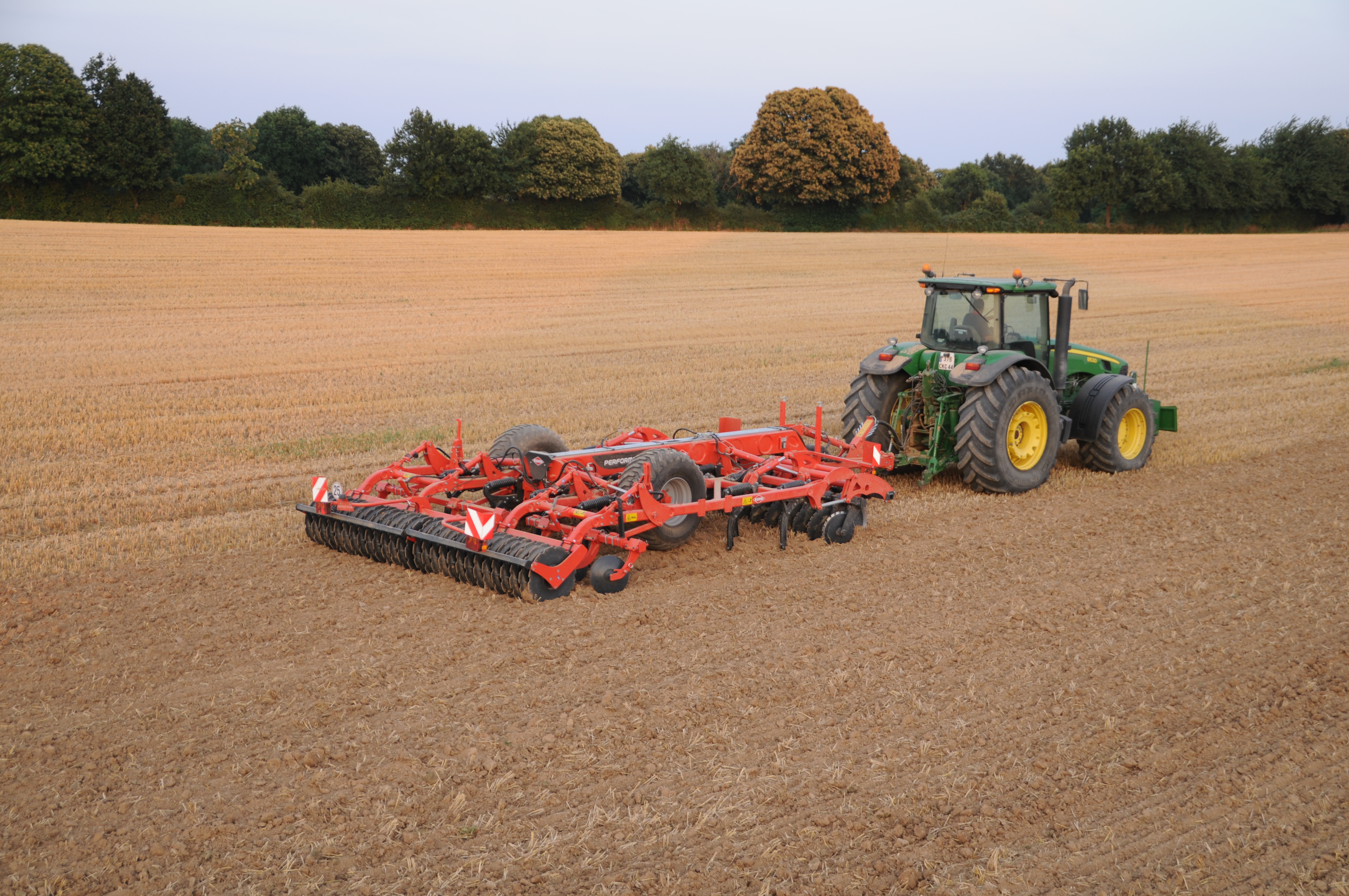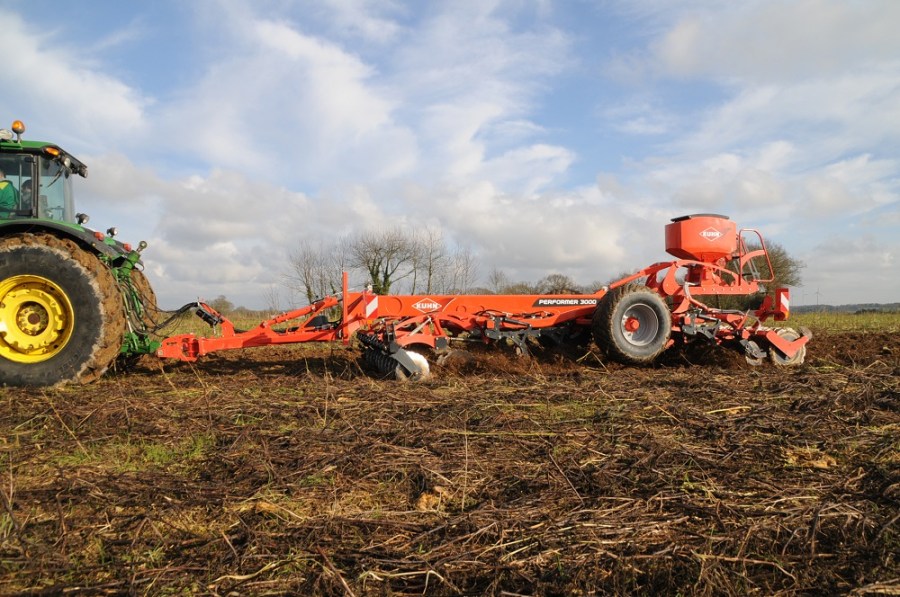Two farmers, on different soils in Hants and in Cambs, have altered their cultivation strategy for quite different reasons, but both have turned to the Kuhn Performer as their chosen tool. CPM finds out why.
We can select which of the individual component parts will combine to give us the best finish.
By David Jones
Covering an area of more than 1100ha all within a 30-mile radius of Romsey, Alan Cook and his two sons Joe and David run Windwhistle Farms from the company base at Sherfield English. The soils vary between chalk, sand gravel and clay cap, which between them can take their toll on the machines employed.
“For quite a while we were using two cultivators to get the job done,” Alan explains. “We had a Sumo Trio and a Väderstad Carrier and while both of them did a good job it was quite time consuming and pretty costly in terms of fuel.”
So, early in 2017, the Cooks decided to look for a cultivator that would be more efficient and give them greater flexibility. Their local dealership, New Forest Farm Machinery, offered to lay on a demonstration of the Kuhn Performer – the 5m 5000 model – and it didn’t take long for Alan to reach the conclusion that this is what they were looking for. The new piece of kit was delivered on farm in time for the autumn campaign.

The Performer 5000 is the mid-range model in Kuhn’s non-powered, deep working disc and tine cultivators, with a working width of 5m.
One of the more obvious reasons for this decision was that the Performer, having a number of tools in its armoury, is able to carry out several tasks at the same time. It has two rows of 510mm discs – 38 of them in all – for cutting through crop residues, followed by 18 tines in four rows that can either mix or just loosen the soil – or both.
Last component in the sequence is a heavy duty, 700mm packer roller that can impose a compaction force of 225kg/m even when working on the heaviest clays. Each section of the Performer can operate independently of the others or selectively with one other. The desired section participation, together with depth control, is activated from the tractor cab by means of the function selector.
Alan’s found over the years that one of the key elements of min-till work is forward speed. “You need a lot of horsepower to do the job properly,” he states. “because if you don’t really move the ground, it won’t work as well as you would want it to.” The power for this task is provided by a 310hp John Deere 7310R, which pulls the Performer at a working speed of 12km/h with the implement set to 3-4cm.
“When we’re getting the ground ready for the drill,” Alan says, “we’re usually running at 10km/h and working down to a depth of 12cm. This way, with this set-up, we’ll normally expect to cover around 40ha/day.”
The amount of pressure these soil types exert on the machines working them is bound to ask questions of the metal in contact with that soil. The Performer was supplied from the dealership with tungsten carbide tips which seem to do the trick. Nevertheless, Alan reckons on getting through one set of tips every 400ha.
He also appreciates the operational flexibility the Performer gives him. “Depending on the soil and the job that we want to do, we can select which of the individual component parts will combine to give us the best finish,” he says.
If the aim is to open up the ground in order to let it dry out, for example, there’s the option to operate without the packer roller. “All we have to do is disengage it using the cab-mounted hydraulic control box. Similarly, we can set it to work the discs only, the tines only, or have all three elements in action,” he states. “It’s a real boost to know that you can achieve any of these options without having to leave the cab.”
However, there was an additional bonus that the Cooks weren’t expecting from their new cultivator: slug kill. Alan describes what they’ve found: “We have a direct comparison in the field from when we started to use the Performer, compared with the equipment we were using previously.
“The difference made by the Kuhn has occurred where we made a deeper cultivation earlier in the year. There’s a very distinct line between the areas covered by the two different machines. We were quite astonished.”
The 5m Kuhn Performer 5000 is compatible for use by tractors of up to 500hp, so the Cooks still have plenty of scope should they reach the situation of needing to up the horsepower available to them. Optimum efficiency will dictate when that point might be reached.
“We’re using the latest version of John Deere’s SF 6000 receiver and integrated solutions technology which allows us to manage all our data on-line, directly from the tractors, combine and sprayer in the field,” Alan reports.
“With this information, we’re in a position to give our customers extremely accurate information on crop inputs, costs, cropping areas and yields,” he adds. “This puts us in the position of being able to do a proper job and, from our own point of view, makes the whole operation so much more cost-effective.”
Environmental driver
One of the earlier Kuhn Performers to be built first arrived at Papley Grove in 2012, initially on a year’s trial. Delivered to Cambs farmer and contractor Martin Lines, he’s been working with the manufacturer, and has made a few tweaks during that period. This qualifies him to have a well considered view of the machine’s fitness for purpose, and Martin says he hasn’t looked back.
“One of the first things I noticed,” he recalls, “is that you could set the whole 5m width to the same depth and not get any waving effect – it moves all the soil. Sometimes we have the wings on, depending on what we want to achieve, with quick and easy adjustment from the cab. In some years you may need to go deeper, particularly if any compaction has built up, which is largely down to the rotation.”
Prior to getting the Performer, Martin’s normal cultivation regime involved a plough/subsoiler/discs routine, but it wasn’t long before he became aware of the advantages the new machine offered. “It was a very wet year, but we able to cultivate when our neighbours couldn’t. We found that it lifts the soil at the front and lets the air in to provide a lovely finish – slightly soft, but the wind then dries it.”
An early request made to Kuhn during the trial period was for more tungsten on the tines. “The clay soils around here are quite demanding on the machinery, but we soon found that we could manage to cultivate 1400ha on a set of tines. We use a 450hp Quadtrac, but it still makes for cheap operating,” he says.
Martin believes the Performer’s versatility is the key to getting crops established in a tricky autumn, but that the machine’s ability to address a range of tasks is its primary appeal. “This can vary from light cultivations at 4-5cm depth, right down to 25-30cm in some fields and using the wings at 10-15cm,” he explains.
“The discs are always doing something – whether it’s just scuffing the surface or pushing down hard when there’s a lot of rubbish to bury. On top of that, it’s a real advantage being able to make most of the adjustments on the move in response to changing field conditions – pushing in if the soil feels tight, for example.” All he needs to do to adjust the tine depth, he says, is to move a numbered slide bar at the front of the machine and move some ram wedges at the rear.
With his participation in the ELS and HLS environmental schemes, Martin became increasingly impressed with the Performer’s ability to help reshape many of his fields; in effect, making less land more productive. The turning headlands were a case in point – and underlined to Martin its flexibility. “I want each individual machine on this farm to do as many jobs as possible,” he states.
“In trying to make each field as square as can be achieved, we’ve managed to take out the more difficult headlands. In some spots we’ve been able to go from regular ponding to occasional patching. Making the fields fit our machines has had a beneficial effect on our overall returns, but I also like to think of it as helping to make nature work with the farming,” he says, with some satisfaction.
The Performer clearly plays a significant role in Martin’s longer-term plans for Papley Grove. “What I’m trying to do here is expand the rotations by means of improving the soil and through weed management,” he explains.
“We need to adapt to a number of things that are happening. One important example is that we’re steadily losing the chemistry available to us, so we’re going have to learn to use it where it’s absolutely necessary, not in a blanket fashion.” The other side of that coin is that environmental enhancement of farmland can also be profitable, he adds.
Profile of a Performer
The Kuhn Performer made its market debut in 2013 in 4, 5, 6 and 7m versions, with a 3m model joining the range last year to satisfy a lower horsepower requirement. In common with the others, Alan Cook’s 5m machine is built around a central beam and has an under-frame clearance of 850mm.
The layout consists of 38, 510mm independent and hydraulically adjustable discs and a total of 18 non-stop hydraulic (900kg) tines that can work to a maximum depth of 350mm, together with 12 levelling discs. Additionally, eight hydraulically adjustable levelling discs can also be employed.
Users can select between shares that mix and loosen the soil – standard 80mm shares, 50mm subsoiling shares or wing shares, while an HD Liner 700 notched roller imposing up to 225kg/m of hydraulically adjustable pressure brings up the rear. The roller’s notched profile design provides rotational consistency, even, Kuhn states, on the heaviest soils.
Said by the manufacturer to have low service requirements, due to the use of maintenance-free hubs and drop-forged tines, the cultivator’s transport width is 3m.
Farm Facts
Windwhistle Farms, Sherfield English, Hants
- Area farmed:1100ha, incl owned, rented on an FBT, share-farmed, contracted
- Main cropping: Winter wheat, oilseed rape, spring wheat, spring barley, linseed, grain maize
- Soil types: Chalk, sand, gravel, heavy clay cap
- Mainline tractors: John Deere 7310, 7280, 6215, 6210
- Combines: JD S685 tracked, with 10.7m Draper header; JD S685 with 9.1m header
- Drill: 6m Väderstad Rapid
- Cultivation: 5m Kuhn Performer 5000
- Sprayer: Amazone Pantera with 36m boom
- Fertiliser spreader: Kuhn 50.2
Papley Grove Farm, Eltisley, Cambs
- Area farmed: 360ha
- Soil type: Hanslope series clay
- Main cropping: Winter wheat, oilseed rape, winter beans, spring barley; ELS and HLS stewardship features on most fields
- Mainline tractors: Case IH Quadtrac 450, Puma 215, JX90; JCB Fastrac 180
- Drill: Väderstad
- Cultivation: 5m Kuhn Performer 5000; Cousins V-form; discs, mole drainer




